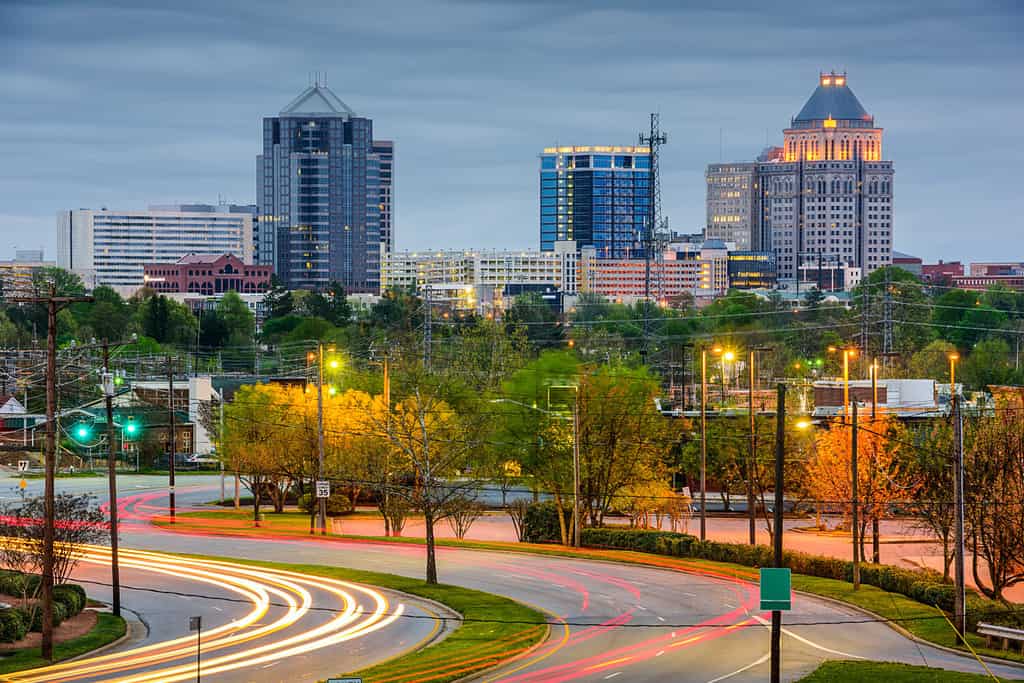Introduction
North Carolina once belonged to the original 13 colonies of the New World, making it one of the oldest states in the country. Featured alongside the state’s incredible and fascinating history are its stunning landscapes, unique topography, diverse wildlife, and beautiful cities. While the largest cities in North Carolina may seem small compared to large cities in the United States like New York or Los Angeles, these towns have much to offer in terms of diverse industries, quality of life, and steady population and economic growth. Discover the largest cities in North Carolina by population, total area, and economy, and find out how these cities compare to one another.
Largest Cities in North Carolina by Population
The largest city in North Carolina is Charlotte with a population of 885,663 residents, as of 2023. The rate of annual population change in Charlotte measures 0.34%. The second-largest city, Raleigh, has a population numbering 472,540 people, which measures a little over half the population of Charlotte.
In addition, the rate of annual population change in Raleigh sits at 0.36%. Charlotte is far beyond Raleigh in population, and both cities maintain a similar rate of growth. Therefore, it is likely that Charlotte, North Carolina will continue to hold the title as the largest city in North Carolina in the future.
Ranking third on the list of the largest cities in North Carolina is Greensboro with a population of 299,175. Greensboro has a rate of annual population change of 0.15%. Durham, North Carolina is the fourth-largest city in the state with a population of 287,794. Durham’s population sits slightly below that of Greensboro. However, the rate of annual population change in Durham exceeds the growth rates of Greensboro, Raleigh, and Charlotte at 0.40%. Therefore, it’s possible that Durham, North Carolina could surpass Greensboro for the #3 spot on the list of the largest North Carolina cities.
Finally, the fifth-largest city in North Carolina is Winston-Salem. The population of Winston-Salem measures 252,274, and the city has a rate of annual population change of 0.39%. Thus, the growth rate of Winston-Salem is almost as large as that of Durham. Since Durham and Winston-Salem have similar populations and growth rates, the two cities could rise together or compete with one another for rankings on the list of the largest cities in North Carolina.

Charlotte is the most populous city in North Carolina with a population of 885,663.
©Sean Pavone/Shutterstock.com
Largest Cities in North Carolina by Total Area
The largest city in North Carolina, Charlotte, has an area covering 308.6 square miles, which translates to 799.3 square kilometers or 197,504 acres. Charlotte holds the title of not only the largest city by population by also the largest city by area. The second and third largest cities in North Carolina by area are Fort Bragg and Fayetteville, measuring 251 and 150.1 square miles, respectively.
On the other hand, Raleigh, which is the second-most populous city in the state, covers approximately 146.5 square miles. Raleigh may be the second-largest city according to population, but it has the fourth-greatest area of all cities in the state. The area of Raleigh can also be calculated in square kilometers and acres, and these values amount to 379.6 and 93,760, respectively.
Furthermore, Greensboro spans 131.8 square miles–or 341.4 square kilometers. The acreage of Greensboro, North Carolina measures 84,352 acres. Thus, Greensboro is only slightly smaller than Raleigh in total area, but the city is significantly smaller than Raleigh when considering population numbers.
Durham, which is North Carolina’s fourth-largest city, covers 106.6 square miles, which is equivalent to 276.1 square kilometers. The acreage of Durham measures 68,224 acres. Although Durham records a higher population than Winston-Salem, North Carolina, Winston-Salem covers a greater area.
In fact, the square mileage of Winston-Salem is greater than that of Greensboro by a meager three square miles. Winston-Salem covers 134.7 square miles, translating to 348.9 square kilometers. Thus, the city spans 86,208 acres, making it larger in area than the third and fourth most populous cities in North Carolina.

The city of Charlotte also holds the title of North Carolina’s largest city by total area, which measures 308.6 square miles.
©iStock.com/digidreamgrafix
North Carolina Economy
The economy of North Carolina is steadily growing at an average rate of increase of 1.8%, according to data recorded between 2017 and 2022. Furthermore, the state’s Gross Domestic Product (GDP) measures $542.1 billion U.S. dollars. Of all 50 states in the country, the state of North Carolina ranks #18 for state growth in GDP. In addition, North Carolina ranks #14 in state growth regarding the number of businesses in the state.
The rate of growth for employment in North Carolina measures 1.4%. In addition, the state’s top industries include finance, manufacturing, real estate, and science and technical services. Other industries, such as banking, car sales, and insurance, continue to bolster North Carolina’s economy, too.
The unemployment rate in the state during April of 2023 measured at 3.4%. Thus, North Carolina ranked around the 30th spot for unemployment amongst the 50 states. For reference, the state with the lowest unemployment in April of 2023 was South Dakota at 1.9%, and Nevada had the highest rate of unemployment at 5.4%.
Economies of the Top Five Most Populous Cities in North Carolina
Cities typically report a GDP per capita as opposed to a total GDP. GDP per capita better demonstrates the living conditions and economic growth within a certain city than GDP does on its own. Thus, people can better understand how wealthy or economically stable a city is by looking at its GDP per capita. Furthermore, the higher the GDP per capita of a certain city, the better quality of life residents are likely to have.
The city of Charlotte, North Carolina recorded a GDP per capita of $62,056 U.S. dollars in 2021. During the same year, Raleigh had a GDP per capita of $54,395, and Greensboro recorded a GDP per capita of $46,394. While Durham, North Carolina is the fourth-largest city in the state, it maintains a higher GDP per capita than that of Charlotte at $68,111.
Finally, Winston-Salem’s GDP per capita measures $53,154, as of 2021. Overall, the highest GDP per capita of the five largest cities in the state belongs to the city of Durham, and the lowest GDP per capita is that of Greensboro. In addition, the GDP per capita of the entire state of North Carolina amounts to $48,836.

Greensboro, North Carolina records the lowest GDP per capita of the five largest cities in the state.
©Sean Pavone/Shutterstock.com
Features of the Top Five Largest Cities in North Carolina
While the populations, total areas, and economies of the largest cities in North Carolina are surely fascinating, other features, such as industries, educational institutions, and history, make these cities unique. Below outlines some features of the top five largest cities in North Carolina.
Charlotte
The industries that dominate Charlotte, North Carolina include manufacturing and banking. Some examples of goods manufactured in this city include metals, food products, and various kinds of machinery. In addition, Charlotte is considered one of the United States’ largest centers for banking.
Charlotte also features various universities, such as the University of North Carolina and Queens College, which was the first college introduced to the state. Finally, some famous figures were born near the city. Two presidents of the United States–James K. Polk and Andrew Jackson–attended school in Charlotte, North Carolina.
Raleigh
Raleigh, North Carolina acts as the capital of the state. Shipping and distribution are large industries in this city, and the manufacturing of technology and food products grew popular in Raleigh following World War II. In addition, research and services, such as chemical development and insurance, are important to Raleigh’s economy.
Many universities lie within the city of Raleigh, including North Carolina State University, St. Augustine’s, Shaw University, and more. Museums of history, art, and science are important features, and historic sites also dot the city. For instance, President Andrew Johnson was born in the oldest house in Raleigh, which is now preserved as a historical site. Another historical site is Fort Raleigh, which housed some of the first European settlers during the 16th century.

Fort Raleigh National Historic Site preserves the earliest European settlements and Native American heritage.
©iStock.com/zrfphoto
Greensboro
Greensboro was named after General Nathanael Greene, who led American troops during the Revolutionary War. One interesting historical fact about Greensboro, North Carolina is that the city was named the capital of the Confederacy during the Civil War for some time. Eventually, the capital was moved further south, but Greensboro acted as the site of many crucial Confederate decisions, nevertheless.
Now, Greensboro’s top industries include insurance, textiles, wholesale distribution, and agriculture. Universities in the city are the University of North Carolina at Greensboro and Greensboro College. Historical sites and exhibits are present throughout the city, including battle sites, the Greensboro Historical Museum, and Chinqua-Penn Plantation.
Durham
Manufacturing in Durham, North Carolina took off with the introduction of tobacco. In addition, textiles became an important sector of manufacturing in the city. The family responsible for much of Durham’s economic growth was the Duke family. While the tobacco and textile manufacturing industries have now been surpassed by technology manufacturing, the Duke family and their business left lasting impacts on the Durham community.
For example, Durham transformed significantly in the areas of education, research, and medicine due to the Duke family’s generosity and wealth. Most everyone is also familiar with Duke University, which remains one of the nation’s best institutions of higher education, located in Durham. Due to the university’s incredible contributions to research and medicine, the city of Durham consistently performs well in research, medicine, and other health-related pursuits.

Durham is a national leader in medical research and health sciences.
©iStock.com/Manjurul
Winston-Salem
Winston-Salem describes the merger of two separate cities in 1913. The city of Winston and the city of Salem joined together during this time, as they were only one mile from one another. The main industries in Winston-Salem include manufacturing and finance. Examples of goods manufactured in the city are textiles, food products, batteries, and, most importantly, tobacco.
In addition, institutions of higher education in Winston-Salem are Wake Forest University and North Carolina School of the Arts. Some historic sites open to visitors of Winston-Salem include Old Salem and Historic Bethabara Park. Furthermore, the home of Richard Joshua Reynolds, who started the tobacco industry in the area, lies within the city and features many incredible pieces of art and sculptures, some of which date back to 1755.
Largest Cities in North Carolina: A Comparison
| Indications of Size | Charlotte | Raleigh | Greensboro | Durham | Winston-Salem |
|---|---|---|---|---|---|
| Population (2023) | 885,663 | 472,540 | 299,175 | 287,794 | 252,274 |
| Rate of Annual Population Change | 0.34% | 0.36% | 0.15% | 0.40% | 0.39% |
| Area (mi2) | 308.6 | 146.5 | 131.8 | 106.6 | 134.7 |
| Area (km2) | 799.3 | 379.6 | 341.4 | 276.1 | 348.9 |
| Acreage | 197,504 | 93,760 | 84,352 | 68,224 | 86,208 |
| GDP per capita (U.S. dollars) | $62,056 | $54,395 | $46,394 | $68,111 | $53,154 |
The photo featured at the top of this post is © iStock.com/albertc111
Thank you for reading! Have some feedback for us? Contact the AZ Animals editorial team.






